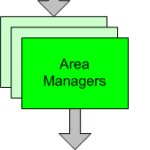

Support
IVHM Design Using eXpress
Top-Down Health Management
A familiar cry heard with most any description of eXpress, is “top-down!”. eXpress can handle both top-down and bottom-up, but it is its top-down capabilities that set it apart. This is especially true for IVHM design because the very notion of IVHM is a system-wide coordinated approach towards fault reporting, diagnosis and remediation.
Although the roots of IVHM are in the safety world, IVHM has quickly moved into the maintenance world as well. The benefits it can bring to such a wide range of problems, also pushes it to the forefront of any effort. The challenges to the design team are in proving IVHM’s merit to ensure it brings the maximum benefit, and does not get thrown onto the chopping block.

Shown to the left is a typical solution to handling both safety critical items that often require immediate reaction, as well as important, but non real-time functions, such as trending analysis. The vehicle management functions tend to be broader functions that factor in the mode of operation, while the area manager functions handle things like engine management, where hundredths of a second count.
It is these types of architecture decisions that must be assessed, fairly quickly within a systems engineering process, in order to support early, proper decision-making.
eXpress brings a unique ability to this problem. As various architectures emerge for implementing the solution, how quickly can you determine the impacts (detection rates, false removals, support costs, etc.) that might be expected with that approach? This is the problem that eXpress solves.
Develop, Assess, Optimize, Repeat
Full optimization of IVHM takes lots of iterations. Each iteration should converge on a solution. It is beyond the scope of this article (see related stories, below, for more information) to discuss trade-studies, but it is this aspect of performing trade studies in a large-scale system design that is essential to IVHM development.
So what are the keys to assessing IVHM in eXpress?
Once some of the basic topology of a design is known, eXpress can be used to provide these statistics:
- Fault Detection and Isolation
- Test Point Utilization and Recommendation
- Fault Group Size and Expected False Removal Statistics
As one progresses, there are more complex statistics that are used to factor in modes of operation, including degraded modes of operation:
- Subset FD/FI Report
- Scope-limited Diagnostic Assessment
- FMECA report, including Detection Method
With these assessments, the next challenge becomes how to use them in such a way to influence decision making at the early point in system development as to make a difference. This is done automatically in eXpress, through its use of data layering.
eXpress is like an onion, right?
To borrow a line from Shrek (R), eXpress really is like an onion. Its layering supports a foundation that begins at the core, the topological model, and continues to the outer edges, upon which assessment takes place.
However, data layering in eXpress goes beyond a simple layering and uses a special technique of abstraction so that changes to test and diagnostics approaches are somewhat resilient despite wide-sweeping design changes. It is this mechanism that allows assessment and optimization to occur throughout the entire design process.
To support the transition from early design studies through later full system integration, there is a crucial change that must take place in the design. Specifically, functions are slowly augmented with failure modes. At the early stages, functions form the connectivity and flow of the model, since that’s what the system level design is comprised of. However, as the design matures, and subsystems enter the picture with increasing amounts of detail, failure modes become the data element upon which testing is often based.
How do you start by assessing functions and later assess failure modes without diverging from the original approach? eXpress provides the only hybrid modeling capability that allows this exact transition to occur at a testing level, without any loss of resolution or changes to the model. As failure modes are entered into the system, tests can be switched, on a component-by-component basis from functions to failure modes.
It is this ability to mesh functions with failure modes that brings eXpress to the earliest stages of development, without incurring a re-entry penalty later, as required by other approaches. In fact, the transition is so smooth, that the functions form the baseline upon which failure mode testing can be based. Of course, the final system testing concept will almost certainly rely on both functions and failure modes, so the functions in eXpress are not deleted–rather, they co-exist with failure modes for the life of the design.
IVHM, having such a system-wide impact, requires a sophisticated layering and abstraction approach to gathering information, to support the fast paced design environment that is created by this type of problem. eXpress, by having this type of problem factored from its beginnings as a design goal, achieves this through simple, object-oriented representation of component, function, failure mode and test data.
* Shrek is a registered trademark of DreamWorks LLC.


